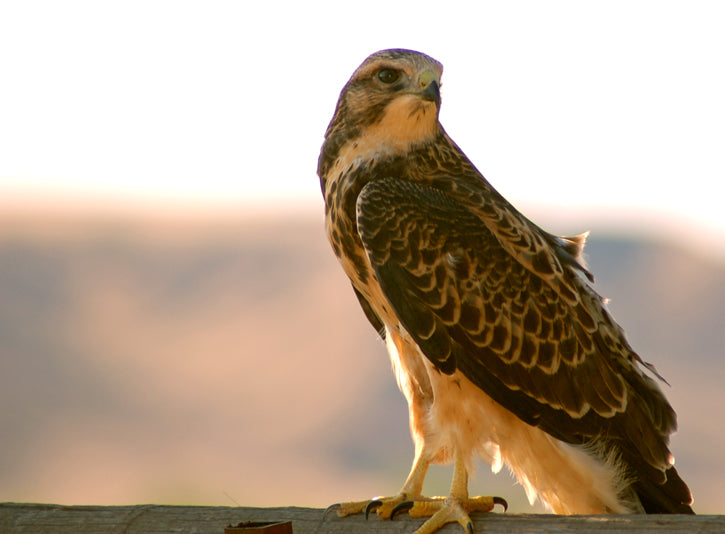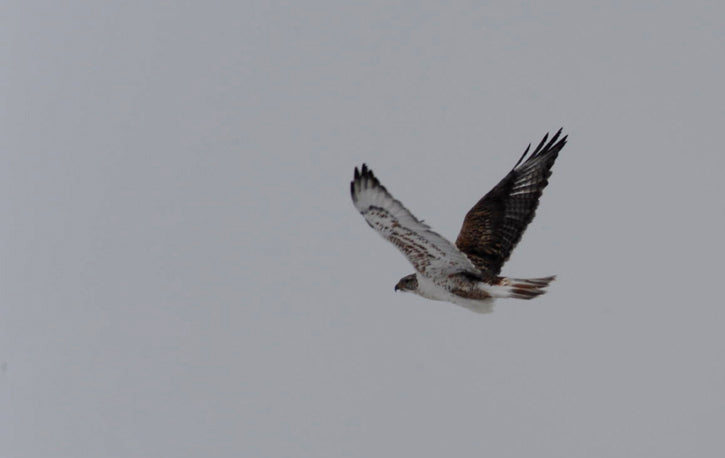This essay appeared in Patagonia’s catalogue focused on falconry. It is reprinted with permission from Patagonia, Inc. Photos by Jill O'Brien
For fifty years my days and dreams have been haunted by falcons, eagles, and hawks. I have been fortunate enough to live close to them. I know the strength of their talons and have felt their surprising weight on my fist. I’ve studied the perfect intricacies of their feathers and smelled their sweet, clean breath.

But anyone who has spent much time out-of-doors knows them too; a dark streak across your path, a spot circling high in a limitless sky, a rush of wings behind an accidentally flushed duck. If you are lucky, you have experienced a frozen instant through a car window, when your eyes meet a cold stare from a fence post. In that breathless flash it is sometimes difficult to tell if the eyes are ferruginous, goshawk, or merlin. There is no recollection of color pattern or body shape. The guidebooks fail us, but we know it was a bird of prey. We can feel it.

Of course we are connected to everything. But with the birds of prey, our connection is uniquely one of envy. Of the great triumvirate of human allies – dogs, horses, and birds of prey – only the birds of prey have remained rooted in the natural world. Our relationship to these three species was originally based in hunting for human survival. These are the species with whom we became partners and the holdover from those ancient days is that dogs are valued for their loyalty, horses for their strength, and birds of prey for their ability to inspire us with a wildness that we have forsaken. While mankind has moved away from their environment, birds of prey have remained part of it.

It is not happenstance that the symbol of many civilizations is a falcon, eagle, or hawk. Their images are cast into coins, shields, sculptures, and elegant jewelry. In his book, “Birds over America”, Rodger Tory Peterson put our relationship with the peregrine falcon into provocative terms. “Man has emerged from the shadows of antiquity with a Peregrine on his wrist. Its dispassionate brown eyes, more than those of any other bird, have been witness to the struggle for civilization, from the squalid tents on the steppes of Asia thousands of year ago, to the marble halls of European kings in the seventeenth century.”
The eyes that Peterson wrote about in 1948 continue to witness our struggle for civilization. While they still observe conquest, invention, and human exertion toward truth and beauty, they have taken on an additional role. In these days of the great environmental crisis, birds of prey have become our conscience and our guides. They choose not to not live in crowded, polluted places. They thrive on pristine landscapes and lead us to what is right and good about the world we are threatening to destroy.
I am forever amazed at the number of environmentally conscious people who were led to their realization of our place on Earth by birds of prey. From childhood I have spent many days at the top of cliffs waiting for a tiny glimpse of a golden eagle or a prairie falcon. I’ve walked endless white-sand beaches and New England woodlots. I’ve cruised the Great Plain in winter, hoping to see gyrfalcons or rough-legged hawks. There have been many companions who have blossomed into scientists, philosophers, visionaries, and eco leaders. Over the years our conversations have been far ranging but, when we found the bird of prey that we were looking for, words always failed us. A thousand times I have been struck speechless to observe a feat of aerobatics, a gesture of dignity, or a sense of nobility beyond the power of man.

Birds of prey are confident and at ease where the Earth is still wild. Follow them into their world. Notice them. Study them. They will call you back to who you really are and bring you to the quiet, beautiful corners of Earth. They will remind you why those corners matter.

17 comments
Beautifully poignant essay, thank you. As a young biologist, I had the life changing experience of manning a peregrine reintroduction hack site in the greater Yellowstone ecosystem which Dan supported in the mid-80’s. We need all the action minded leaders like Yvonne and the entire Wild Idea team we can get!
Lovely essay
Re-reading your books each year has become one of my “Rites of Autumn”
Thank you
A beautiful essay. Thank you.
I started reading your books when the first thing I did after moving from the east coast to Minnesota. I appreciated reading your works on birds of prey. As a very amateur birder and a scientist and science teacher. Your work has meant a great deal over the years. Your books about birds will always be my favorite. THANK YOU!
My daughter is followed by birds of prey frequently.
There are a pair of hawks that live in a tree in the pasture where she keeps her horses , when she calls her horses the hawks are not far behind , circling over head , they follow her ride into the fields and meadows around the place.
A golden eagle landed on a post in front of her close enough to reach out and touch and calmly sat and watched her. She went on about her buisness talking to him. When he left he let out a eagle’s screech , spread his huge wings and flew off . We keep watching for his return but have not seen him .
We live in North eastern Montana, it is remote and empty out here, so we see many many birds of prey of all kinds.
We cant keep cats at the barn because the great horned owls get them.
Now we are wishing for barn owls to keep the mice and pigions out of the barn . And wishing eagles would thin out the coyotes .🤔 humm wondering if we could teach them to do that 😊. I am liking this idea.
I love watching for birds……..they are so majestic and beautiful. I have gotten photos of eagles and red tails. I watch the skies as we travel and on countless occasions my husband has pulled to the side of the, circled around and waited patiently while I try to get the " perfect picture"!
Hi Dan! I remember you with your glove, the hood and pieces of meat training your falcon(s) in your backyard during high school years! I was fascinated how you had gotten nets up over the canopy of tall hardwoods to create a backyard, natural aviary! That was impressive. And you’ve remained involved w/ them all these years. Very cool.
I find myself speechless to relate that I agree wholeheartedly with what you wrote since I’ve experienced that cold stare firsthand many times which drives me to experience it as much as I can while I’m still alive. I have a picture of my daughter with a kestrel in hand while we were at a MN raptor center release and see that look in her eye that makes me keep that picture long after it was taken. Thanks Dan.
What a coisdence. My wife daughter and I just got home from hiking the Scottsbluff National Monument and while we were sitting take a break we seen two sparrow Hawks hunting and swoop down and catch their pray. What an awesome sight to nature at her best
At the Midwestern university where I worked, a peregrine showed up and took up residence as we had an abundance of pigeons in town. Our facilities folks worked with the biology department and built a peregrine nesting platform and installed it on top of our tallest residence tower. The peregrine, unfortunately moved on as no mate showed up. But they do live in cities because there’s plenty of prey. And our own closely built subdivision has a Cooper’s hawk flying through trees in search of songbirds at bird feeders.
Such an awesome article ! It makes me want to get out in a wild place to just sit , watch & listen !
Thank you….these birds are absolutely stunning. I can remember my son spent endless hours creating a statue of a Peregrine falcon. When he brought it to school he was awarded for his excellence and detail in artistry. Then another boy became jealous and took to destroying my son’s prized creation. My son took his falcon home and painstakingly and tirelessly worked to repair it. He still has that Peregrine falcon to this day on his bedroom dresser.
We humans need to be better stewards of our environment so these beautiful and majestic creatures can flourish.
I spend a fair amount of time looking for birds. I once had a Peregrine falcon stoop right over my shoulder from behind me toward a group of sandpipers I was watching. He missed and looked kind of pissed off. It sounded like a bullet going by, and was absolutely thrilling.
Birds of prey are amazing. We get Cooper’s hawks hunting our bird feeders most winters, and it is fascinating to see how their hunting techniques evolve as the season progresses. They are smart and adaptable. We had one that figured out the ideal angle to chase doves into our storm door, and did it the rest of the winter.
Dan…always proud to brag that “I knew you when” on South Main Street in Flag City. Congratulations on your many accomplishments!
Dave